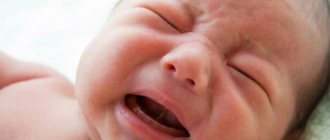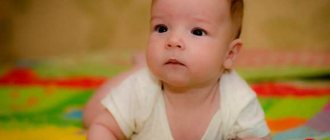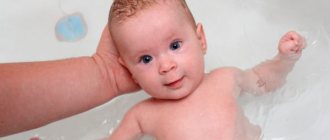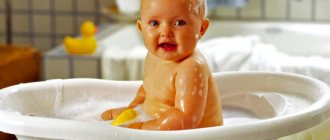Stopping breathing at night is a dangerous pathology that is more common in children. As a rule, infants whose respiratory system is not yet fully developed are more at risk.
There are many reasons why apnea occurs in children, and some can provoke a very dangerous condition, including death. Therefore, mothers and fathers should know how to provide first aid to the baby, and how to prevent the occurrence of new attacks in the future.
What kind of pathology is this
Why does a child hold his breath in his sleep? The reason for this is apnea syndrome. This pathology is characterized by sagging of the oropharynx during night rest at a time when the pressure decreases. Then, there is a sharp reduction in air intake and breathing is held. Such attacks last about a minute and negatively affect the baby’s condition.
Important: During sleep, a child can experience up to one hundred seizures per night. In this case, the child will shudder, and therefore there can be no question of normal rest.
The precursor to sleep apnea is snoring. This condition provokes air deficiency in the child, due to which, over time, dangerous defects are formed, such as:
- growth slowdown;
- abnormal bite formation;
- slow mental development;
- brain hypoxia;
- psycho-emotional disorders.
Intermittent breathing during sleep in a child requires immediate therapeutic elimination. It is important to understand that such a condition can provoke diseases much more dangerous than those listed above.
Types of defect in children
Holding your breath, called apnea, has three types:
- central idiopathic type. Pathology occurs due to a malfunction of the respiratory center. In this condition, muscle mass does not contract due to the lack of a signal;
- obstructive apnea. In this condition, the attack occurs due to obstruction of the respiratory passages. As a rule, children under one year of age are susceptible to this form in most cases;
- and the third type is a mixed form. If this type occurs, a central type of apnea is first observed, turning into obstructive. It is worth noting that the third type is observed in a few cases out of a million.
Important: Snoring is a valid cause for concern. When this symptom appears, parents should take the child to the doctor as soon as possible. Moreover, if such a condition is observed regularly, it is necessary to conduct extensive diagnostics.
Each of the listed types of apnea has a specific therapeutic technique. Therefore, in this condition, you should not resort to dubious treatment methods. Otherwise, you may make the existing problem worse.
Preventive measures
To prevent breath holding, it is important to follow these rules:
- The room needs regular ventilation.
- It is very important to treat colds to the end.
- During routine examinations, tell the pediatrician the nuances of your child’s well-being, and also tell him in detail about his complaints. If necessary, the doctor will write a referral for Doppler testing.
Remember that only a doctor can correctly assess the condition of the airways, blood vessels and heart.
Source: polintermed.ru
Symptoms of the disease
In order to promptly detect and eliminate nocturnal breathing pauses in infants, parents need to monitor the quality of rest and sleep behavior. In addition, knowledge of symptoms will help to identify the problem in a timely manner, namely:
- during a sound sleep, the child holds his breath for more than 10 seconds;
- snoring appeared;
- the baby breathes through his mouth;
- Anxious behavior is observed during sleep;
- there is strong sweating;
- periodically during the daytime the baby complains of a headache;
- developmental delay.
Important: The first sign of an attack is the child’s face and fingertips turning blue. In addition, there is a weakening of muscle tone, and the pulse gradually slows down.
During an attack of apnea in newborns, hypoxia occurs. This provokes waking up. In addition, older children may become frightened due to the release of adrenaline into the blood. Against this background, appetite may worsen and developmental delay may occur.
Complications
Sleep apnea is most often observed in children aged 2 to 6 years. By about 4 years of age, the elimination of unpleasant symptoms of the disease is diagnosed. In some cases, pathology can be observed even in adult patients.
The most dangerous thing in infants is that respiratory arrest occurs at night. At the same time, the baby’s skin turns blue, the functioning of the cardiac system is disrupted and oxygen starvation is observed.
Breath holding is most often diagnosed in premature babies. This is explained by the defective formation of respiratory centers in the brain.
Also, the occurrence of a pathological condition can be observed against the background of birth injuries, heredity, complications during pregnancy, and infectious diseases.
If a child stops breathing for more than 10 seconds, this is apnea. It is most often observed in children over two years of age. In some cases, pathology is observed a little earlier.
The video shows expert advice for parents:
May 24, 2021 Yuki 402
Share this post
We recommend reading along with this article
- How to cure chronic tonsillitis in a child, what remedies...
- Hemangioma on the head of a child: types and treatment
- Treatment of tonsillitis during pregnancy: whim or necessity
- A child coughs at night: what should parents do?
- Types of lichen in children and features of treatment of the disease
- How to treat a cough with sputum in a child - folk...
- Signs of poisoning in children by various substances
- Tachycardia - what is the danger of heart disease and how to treat it
- Symptoms and treatment of false croup in children
Discussion: there is 1 comment
- Catherine:
06/03/2017 at 00:19My child is 1.4 and I also notice that he sometimes holds his breath. Usually not for long, for 3-5 seconds, but somehow it still worries me. Based on the article, this could be a serious problem. I don't know if I should panic?
Answer
Why does breathing stop?
Factors that cause nocturnal respiratory arrest are classified depending on the type of syndrome. As mentioned above, there are two main and a third transitional type.
So, the reasons for the emergence of the central type:
- injuries to the brain and spinal cord in infants received during childbirth;
- early labor, resulting in the birth of a premature baby;
- epileptic seizures;
- deficiency of glucose in biological fluid;
- failure of gas exchange;
- diseases of viral and bacterial origin;
- use of a number of drugs by a pregnant woman;
- sepsis.
As for the obstructive type, such a violation is provoked by the following reasons:
- defective language development;
- spasm of the laryngeal muscles or laryngospasm;
- pathological bone development;
- injury to the muscle mass of the larynx;
- abnormal enlargement of the tonsils;
- obesity and accumulation of excess weight in the cervical area;
- anomaly of the lower jaw.
Important: You can detect a seizure in a baby by observing how he sleeps. If breathing is intermittent and after inhaling a short snore is heard, and then there is a slight cessation of breathing, it means that an attack is occurring. In this case, the sleeping child may toss and turn or try to change his sleeping position.
It is possible to defeat sleep apnea only by eliminating the cause of its development. In view of this, parents need to consult a doctor. Remember, by strictly adhering to the prescribed therapeutic measures, you will overcome not only nighttime respiratory arrest, but also concomitant pathologies.
Diagnosis of breathing in babies
If you have frequent episodes of periodic breathing, you should definitely show your child to the pediatrician. He may be prescribed an examination - polysomnography. It is carried out in a hospital and can take several days (more precisely, nights). Before going to bed, high-precision sensors are installed on the child’s body, which will record physiological processes in the body throughout the night. The results show the number of breathing stops and their duration.
In newborns and infants, breathing can normally be intermittent and uneven, since not all systems and organs have had time to “ripen”. Before visiting a doctor, it is recommended to measure your breathing rate at home. In infants, the measurement process can be carried out visually by observing the rise of the chest for a minute. You can simply place your hand on your baby's chest and count the breaths.
Respiration rates vary:
- newborn – 40–60 breaths per minute;
- 1–2 months – 35–47;
- up to three years – 28–35;
- 4–9 years – 24–30;
- 10–12 years – 18–20.
Write down the readings on a piece of paper and show them to your local pediatrician. Additionally, examinations by an otolaryngologist, neurologist and other “narrow” specialists may be required if the cause of periodic breathing or apnea is pathology.
Establishing diagnosis
Making a diagnosis begins with parents identifying the problem. The following symptoms should raise suspicion:
- restless and interrupted sleep;
- baby's moodiness;
- loss of appetite;
- lethargy and drowsiness during the daytime.
If these signs occur, parents should immediately consult a doctor. The first action of a specialist is a thorough study of all the diseases that the baby has suffered from. In addition, heredity is subject to detailed analysis.
Then comes the assessment of body weight and the cervical spine weight index. Also, in some cases, you may need to consult a cardiologist, neurologist and otolaryngologist. The fact is that in some cases, symptoms such as weakness and difficulty breathing through the mouth also occur with adenoids.
Parents' actions during an attack
Holding your breath at night in children of all ages can cause asphyxia. And this condition is already fraught with death. In view of this, parents need to know how to behave when such a condition is detected. So, when you urgently need to call emergency services:
- slow pulse, less than 90 beats;
- the appearance of a bluish color in the area of the wings of the nose, around the mouth and on the limbs;
- involuntary drooping of limbs.
Important: To prevent breathing from stopping, it is recommended to thoroughly ventilate the baby’s bedroom, prevent overheating of the newborn by excessively wrapping it, and try to take air baths as often as possible.
In addition, before emergency assistance arrives, parents must do the following:
- perform artificial respiration;
- put the baby in a horizontal position;
- examine the tongue for retraction;
- take the mouth with your fingers, cover the nose and blow air until the child begins to move in the chest area.
If there is no pulse, mom or dad should perform a heart massage while simultaneously breathing air into the baby's mouth. The massage is performed until the doctor arrives.
Treatment strategy
After a comprehensive examination of the child, a therapeutic program is developed. Taking into account the severity of the violations, the following technologies are often used:
- Rinsing the nasal passages and prescribing special medications.
- Creating positive pressure on a continuous basis in the airways so that air flow is continuously supplied to the body. This CPAP technique is safe for children.
- Removal of tonsils, that is, denotonsillectomy , is used for pathology and diseases of the ENT organs.
- Positional therapy , that is, treatment by changing body position .
- Surgical treatment vulopalatopharyngoplasty. Its purpose is to widen the airways when soft tissue is partially removed.
What are the possible consequences of pathology?
The consequences of such a pathology result in dangerous complications, especially when it comes to one-year-old children. In this condition, against the background of oxygen deficiency, the following defects develop:
- Children often develop hyperactivity;
- the inability to concentrate is formed;
- pathological conditions of the heart muscle;
- increased drowsiness and arrhythmia;
- natural development and growth slows down.
In addition, at an advanced stage, there is a high risk of developing ischemic pathology, heart attack and stroke due to disruption of the heart muscle. Also, children suffering from short-term breath holdings are more susceptible to various injuries.
Treatment options for apnea
Treatment of the pathology in question begins with eliminating the root cause that provoked this dangerous condition. For these purposes, the following methods are used:
- if the problem is a malocclusion, it will need to be corrected through surgical correction;
- if you are obese, you need to consult a nutritionist and gradually reduce body weight;
- in the case when nighttime respiratory arrests are dependent. In other words, apnea occurs when the child takes a certain sleeping position; you need to wean the baby from sleeping in this position.
Important: If the culprit is excess soft tissue mass, it must be partially excised. In the case where apnea is caused by a defect in the nasal septum, it is impossible to correct the problem in childhood.
In this case, maintenance therapy will be required until the little patient reaches adulthood.
In some cases, surgery is contraindicated. Therefore, the doctor may recommend CPAP therapy. This method allows you to block interruption of breathing through artificial ventilation. CPAP therapy eliminates the possibility of hypoxia and creates optimal conditions for normal oxygen supply to the brain.
Operationally
Treating apnea with surgery is indicated when the cause of the pathology is the presence of acquired or congenital defects of the respiratory tract. In such conditions, the following types of manipulations are indicated:
- in case of abnormal development of the tonsils, tonsillectomy is recommended;
- if shortness of breath is caused by adenoids, adenoidectomy is prescribed;
- To eliminate the curvature of the nasal septum, surgical correction is indicated;
- less often, but tracheostomy may be recommended if the culprit of apnea is obstructive pathology or abnormal development of the airways;
- and the last method, which is also used in rare cases, is uvulotomy, excision of the uvula.
In general, the effectiveness of surgical intervention reaches 100%. However, a month after the manipulation, a re-examination of breathing will be required.
CPAP therapy
As mentioned above, this method is used when surgical intervention is contraindicated for some reason. With this type of treatment, a mask with a hose is put on the baby before going to bed, through which the air produced by the device flows.
Using this method, inhalation and exhalation becomes uniform and deep. However, it is worth emphasizing that the device must work continuously both during the day and at night.
Unfortunately, CPAP therapy has a short-term effect. Once you stop using the delay equipment, uneven breathing returns. There are also positive aspects to this. By resorting to this method of treatment, parents have the opportunity to block hypoxia until the facial skeleton is fully formed.
Of course, treating a child with this method takes a long time, however, reviews say that with the help of CPAP therapy you can forget about apnea forever, provided that the facial skeleton is fully formed.
Sources of sleep disorders
It should be immediately noted that most often periodic breathing appears in infants who are not yet six months old. For such babies this is quite normal. Doctors' intervention is not required here, even if up to 7-8 percent of the night time is paused. In the case of sleep apnea, it must be treated immediately.
As for older children, uneven breathing may appear in the following situations:
- Lack of oxygen , when possible cyanosis of the extremities, as well as the skin of the body and around the mouth. This usually affects children one year old and younger. The picture is like this: the baby is gasping for air, it is difficult for him to breathe fully.
- Diseases of infectious etiology . In children, whistling, heavy snoring, and even gurgling are also added. If there are inflammatory processes in the lungs, the rhythm of inhalation and exhalation often increases.
- Increased body temperature : the rhythm is lost, there is shortness of breath, which can also occur with cardiac problems.
- Bronchitis with obstruction and croup , which is called false. The rhythm also becomes disrupted, noisy and loud exhalation appears, and the child coughs.
In addition, adenoids and obesity, diabetes mellitus and nervous diseases, heredity and birth injuries can be the basis for respiratory disorders.
Komarovsky about apnea in children
The famous pediatrician Komarovsky believes that parents will be able to alleviate the child’s condition during nighttime respiratory arrests if they follow the following rules:
- ventilate not only the children’s room, but the entire home every day;
- wash floors more often and remove dust, not giving it a chance to accumulate;
- remove all carpets and other objects that accumulate dust from the nursery;
- install a humidifier in the room;
- to moisturize the mucous membrane of the nasal passages, instill a saline solution;
- Make sure your child drinks plenty of fluids.
Important: According to Komarovsky, the reason why apnea occurs in children is dry air and a large accumulation of dust.
These simple rules will prevent the development of adenoids and protect against atrophy of the tonsil. In turn, the child will not experience snoring, as the main harbinger of apnea.
Preventive actions
So, we looked at why apnea occurs and how to overcome this pathology. It remains to summarize and note that it is much easier to prevent the development of this most dangerous condition. To do this, follow these tips:
- put the baby on his side to sleep;
- use bedding made from natural fabrics;
- purchase an orthopedic mattress;
- Ventilate the room more often and do not wrap your baby up.
Teach your children from a young age to lead a healthy lifestyle and then such a dangerous disease as apnea will not bother your family.









